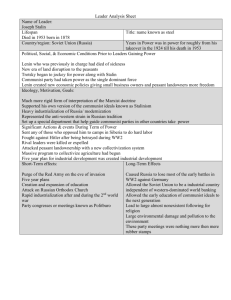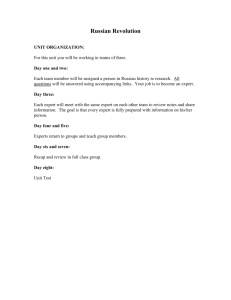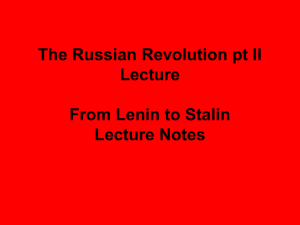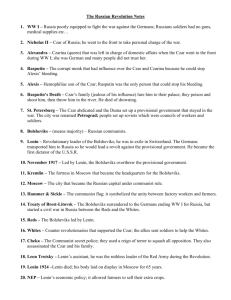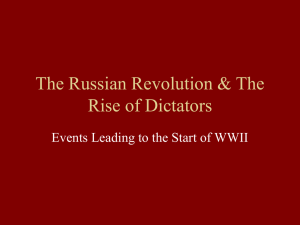Chp. 14 Russian Revolution
advertisement
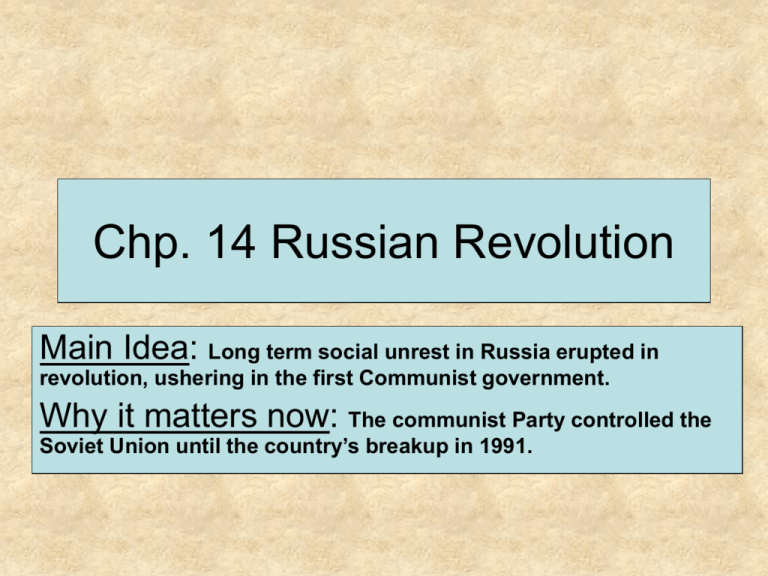
Chp. 14 Russian Revolution Main Idea: Long term social unrest in Russia erupted in revolution, ushering in the first Communist government. Why it matters now: The communist Party controlled the Soviet Union until the country’s breakup in 1991. The oppressive rule of most 19th-century czars caused widespread social unrest for decades. Anger over social inequalities & the ruthless treatment of peasants grew. The czar’s unfair governing sparked many violent reactions. In 1881, Alexander III succeeded his father, Alexander II, to the throne & halted all reforms in Russia. He clung to the principles of autocracy, a government in which he had total power. Anyone who questioned the absolute authority of the czar or worshiped outside the Russian Orthodox Church or spoke a language other than Russian was tagged as dangerous. To wipe out revolutionaries, Alexander III used harsh measures: •He imposed strict censorship codes on published materials & writing documents, including private letters. •His secret police carefully watched both secondary schools & universities. •Teachers had to send detailed reports on every student. •Political prisoners were exiled to Siberia, a region of eastern & central Russia To establish a uniform Russian culture, he oppressed other national groups within Russia: •He made Russian the official language & he forbade the use of minority languages, such as Polish in schools. •He made Jews the target of persecution. He subjected them to new laws that encouraged prejudice. •Jews could not buy land or live among other Russians. •Universities set strict quotas for Jewish students. •Organized violence against Jews broke out in many parts of Russia called pogroms. •Police & soldiers stood by & watched Russian citizens loot & destroy Jewish homes, stores & synagogues. Pogroms: Pogroms were a form of race riots, most commonly Russia & Eastern Europe, aimed specifically at Jews & often government sponsored. Pogroms became endemic during a large-scale wave of anti-Jewish riots that swept southern Russia in 1881, after Jews were wrongly blamed for the assassination of Czar Alexander II. In the 1881 outbreak, thousands of Jewish homes were destroyed, many families reduced to extremes of poverty; women sexually assaulted, & large numbers of men, women, & children killed or injured in 166 Russian towns. The new czar, Alexander III, blamed the Jews for the riots & issued a series of harsh restrictions on Jews. Large numbers of pogroms continued until 1884, with at least tacit inactivity by the authorities. An even bloodier wave of pogroms broke out in 1903-1906, leaving an estimated 2,000 Jews dead, and many more wounded. A final large wave of 887 pogroms in Russia and the Ukraine occurred during the Russian Revolution of 1917, in which between 70,000 to 250,000 civilian Jews were killed by riots led by various sides. The victims, mostly Jewish children, of a 1905 pogrom in Dnipropetrovsk Jews had long felt insecure within the Russian Empire &, after the assassination of Alexander II, they were driven from the countryside & forced to live in the towns along the Pale of Settlement, excluded from education & from public service. As a result, most Jews belonged to the lowest stratum of the unemployed or worked as artisans & small masters. Many fled the Russian Empire, mainly without passports, largely to escape poverty, military service & personal violence. In 1894, when Nicholas II became czar, he announced, “The principle of autocracy will be maintained by me as firmly & unswervingly as by my father (Alexander III)” He Refused to surrender any of his power. At the beginning of Nicholas II’s reign, Russia lagged behind the industrial nations of western Europe. In the late 1890’s Sergey Witte (VYEET-tyih), the czars minister, launched a program to move the country forward or to get them up to speed with the other industrial nations. Through higher taxes & foreign investments, Witte helped finance the buildup of Russian industries. The number of factories doubled between 1863 & 1900 & by 1900, Russia had become the world’s fourth largest producer of steel behind the U.S., Britain, & Germany. He also pushed for the building of the TransSiberian Railway-the world’s longest continuous rail line. With the help of British & French investors, work began in 1891 & was completed in 1904. It connected European Russia in the west with Russian ports on the Pacific ocean in the east The growth of factories brought new problems among the people of Russia: •Grueling working conditions •Low wages •Child labor •Trade unions were outlawed However, laborers who worked on the railways & in factories & who were unhappy with their low standard of living & lack of political power, still organized strikes. The gap between rich & poor was enormous. Amidst all the widespread industrial changes and unhappy workers, a revolutionary movement began to grow. They competed for power and eventually succeeded. They established a new government based on the views of Karl Marx. These revolutionaries believed that the industrial class of workers would overthrow the czar. The industrial class would then form “a dictatorship of the proletariat.” In such a state, the workers would rule. Note: The revolution had not started at this point. It only began to pick up steam due to the poor labor conditions that were taking place. In 1903, the Russian Marxists split into two groups over revolutionary tactics: •The Mensheviks (MHEN-shuh-vihks): a group who wanted a broad base of popular support for the revolution. •The Bolsheviks (BOHL-shuh-vihks): a group who supported a small number of committed revolutionaries willing to sacrifice everything for radical change. The major leader of the Bolsheviks was Vladimir Lenin. He had an engaging personality & was an excellent organizer. He was also ruthless. These traits would ultimately help him gain command of the Bolsheviks. In the early 1900’s, Lenin fled to western Europe to avoid arrest by the czarist regime. He maintained contact with other Bolsheviks. Lenin then waited until he could safely return to Russia. Between 1904 & 1917, Russia faced a series of crises, which exposed the weakness of the czar & paved the way for revolution: First: In the late 1800’s, Russia & Japan both competed for control of Korea & Manchuria. The two nations signed a series of agreements over the territories, but Russia broke them. In retaliation, Japan attacked the Russians at Port Arthur, Manchuria, In Feb. 1904. Though Russian soldiers & sailors went confidently to war, the Japanese defeated them. The news of the repeated losses sparked unrest at home & led to revolt in the midst of the war. Port Arthur Second: On Jan 22, 1905, about 200,000 workers & their families approached the czar’s winter palace in St. Petersburg. They carried a petition asking for better working conditions, more personal freedom & an elected national legislature. The czar Nicholas II was not at the palace, however his generals & police chiefs were. They ordered the soldiers to fire on the crowd. Between 500 & 1,000 unarmed people were killed. The event was called, “Bloody Sunday” . Bloody Sunday started a wave of strikes & violence that spread across the country. As a result, in Oct. 1905, Nicholas reluctantly promised more freedom. He approved the creation of the Duma – Russia’s first parliament. The first Duma met in May of 1906. Its leaders wanted Russia to become a constitutional monarchy similar to Britain. But hesitant to share his power, the czar dissolved the Duma after 10 weeks. Other Dumas would meet later, yet none would have real power to make sweeping reforms. Third: World War I The Czar Nicholas II made the fateful decision to drag Russia in WWI. Russia, however, was not prepared to handle the military & economic costs. Before one year had passed, more than 4 million Russian soldiers had been killed, wounded, or taken prisoner, once again exposing the weakness of Nicholas II & the Russian military leadership. Ultimately, the war was destroying the morale of the Russian troops. Soldiers mutinied, deserted or ignored orders. In 1915, Nicholas moved his headquarters to the war front. His wife Czarina Alexandra, ran the government while he was away. She ignored the czar’s chief advisers & instead she fell under the influence of the self-described “holy-man” Rasputin. Czarina Alexandra Rasputin Rasputin claimed to have magical healing powers. “Wonderful tales were told of how the stares could look into every man’s soul, foresee the future, and heal the sick by a glance of his eyes or a touch of his hands.” Alexis, Nicholas & Alexandra’s son, suffered from hemophilia, a life-threatening disease. Healing was what the Empress Alexandra needed most, not only for her sick son, but for herself. Already she had attempted mystical cures prescribed by a French savant, and in her court was a mysterious Tibetan physician, Dr. Badmaev. Soon Rasputin was added to her routine. Significantly, he was introduced to the royal couple on Halloween. With a forthright manner, blustery charm and hypnotic gaze, Rasputin soon became indispensable to both Nicholas and Alexandra, not only religiously and medically, but politically as well. Medically, his powers were amazing. Often he would cure the czarevich from hemorrhaging by telegram. For example, in the autumn of 1912, Alexi suffered a bump which resulted in internal bleeding. Days passed without an abatement in the bleeding. Finally, sacraments were given, and on that night the Empress telegraphed Rasputin for help. Rasputin telegraphed in reply, “God has seen your tears and heard your prayers. Do not grieve. The Little One will not die. Do not allow the doctors to bother him too much.” Alexandra followed these instructions and the next day the hemorrhaging stopped. As a result, Alexandra allowed Rasputin to make key political decisions. He opposed reform measures & obtained power positions for his friends. He spread corruption throughout the royal court. In 1916, a group of nobles murdered Rasputin. They feared his increasing role in government affairs. Revolution Occurs in March 1917 •Women textile workers in Petrograd lead a citywide strike. •Soon after, riots flare up over shortages of bread & fuel. •Nearly 200,000 workers swarm the streets. •Soldiers obey orders to shoot the rioters, but later they side with the rioters. •The soldiers fire at their commanding officers & join the rebellion. •Large crowds gather & shout… “Down with the autocracy!” “Down with the war!” The March Revolution forces Czar Nicholas II to abdicate his throne. A year later, on July 17, 1918, the Czar Nicholas, his wife, Alexandra, their five children and four family attendants were herded into a cellar room by their Bolshevik captors and killed in fusillade of bullets and stabs of bayonets. According to a report by the Czar's chief executioner, two of the bodies taken from the Yekaterinburg cellar were burned, and the rest buried. The missing bodies belonged to the Romanov heir, Alexei, who was 13 when he was killed, and one of his sisters, either Maria, then 19, or her 17-year-old sister Anastasia. Leaders of the Duma establish a provisional (temporary) government, which was eventually headed by Alexander Derenshy, who decided to continue fighting the war. This decision cost him the support of both soldiers & civilians. As the war continued on, conditions inside Russia became worse: Angry peasants demanded land. City workers grew more radical Social revolutionaries who competed for power formed Soviets – Soviets were local councils consisting of workers, peasants & soldiers. In many cities, especially Petrograd, the soviets had more influence than the provisional government. Petrograd Lenin Returns to Russia The Germans arrange for Lenin’s return to Russia after many years of exile. The Germans believe that Lenin & his Bolshevik supporters would cause unrest in Russia & hurt the Russian war effort. Traveling in a sealed railway boxcar, Lenin reaches Petrograd in April 1917. Lenin & the Bolsheviks soon gain control of the Petrograd soviet, as well as the soviets in other major Russian cities. By the fall of 1917, people in the cities were rallying to the call, “All power to the soviets.” Lenin’s slogan – “Peace, Land, & Bread”- was gaining widespread appeal, so he decides to take action. Bolshevik Revolution In Nov. 1917, without warning, Bolshevik Red guards made up of armed factory workers stormed the winter palace in Petrograd. They took over government offices & arrested the leaders of the provisional government. The Bolshevik Revolution was over in a matter of hours. Within days after the takeover, Lenin orders that all farmland be distributed among the peasants. He gives control of factories to the workers. He also signs the Treaty of Brest-Litovsk in March, which angers many Russians because they had to surrender a large chunk of land to Germany & their allies The Bolsheviks faced a new challenge – stamping out their enemies at home. Their opponents formed the White Army. The leader of the Red Army (the Bolshevik Army) was Leon Trotsky. The Red Army was named after the color of the Bolshevik flag. Eventually the Bolsheviks came to be known as Reds. From 1918 to 1920, civil war raged in Russia. Around 15 million Russians died & the famine that followed, along with a worldwide flu epidemic left Russia in chaos. In the end, the Red Army triumphed. War & revolution destroyed the Russian economy, trade was at a standstill, industrial production dropped & many skilled workers fled to other countries. Lenin shifted his role & he turned to revive the economy & restructure the government. In March 1921, he launched a New Economic Policy (NEP). Under the NEP, he temporarily put aside his plan for a state-controlled economy. Instead he resorts to a small scale version of capitalism: •It allowed peasants to sell their surplus crops instead of turning them over to the government. •Individuals could buy & sell goods for profit. The government kept control of major industries, banks & means of communication. •It let some small factories, businesses & farms operate under private ownership. •Lenin also tried to encourage foreign investment. Political Reforms Lenin began political reform by organizing Russia into several selfgoverning republics under the central government. In 1922, the country was named the Union of Soviet Socialist Republics (USSR), in honor of the councils that helped launch the Bolshevik Revolution. Each republic was controlled from the new capital - Moscow Moscow The Bolsheviks also renamed their party the Communist Party Lenin’s beliefs were developed from those of a man called Karl Marx who is considered the father of communism. •He felt that the rich abused the poor and that they should help them •He believed that anybody making a profit was abusing everybody else •He believed that everybody was equal •He wanted a government that truly represented the people In 1924, the Communists created a constitution based on socialist & democratic principles. In reality, Lenin had established a dictatorship of the Communist Party - The Communist Party held all the power Thanks partly to the new policies & the peace that followed the civil war, the USSR slowly recovered, by 1928, the country’s farms & factories were producing as much as they had before WWI. Lenin did not live to see this recovery. In May of 1922, Lenin had his first stroke. His right side was paralyzed. He had another in December of 1922, where he resigned from all political offices. In March of 1923, Lenin had his third stroke and was left bedridden and unable to speak. During his fourth stroke on January 21, 1924, Lenin died of complications. Only eight out of the 27 physicians that did an autopsy on Lenin believe that he died from a stroke. Another theory is that he died of syphilis. His death in 1924 opened a power struggle for control of the party & the country. Lenin was embalmed and put on permanent display in the Lenin Mausoleum in Moscow. Totalitarianism Main Idea: After Lenin died, Stalin seized power & transformed the Soviet Union into a totalitarian state. Why it Matters Now: More recent dictators have used Stalin’s tactics for seizing total control over individuals & the state. Both Leon Trotsky & Joseph Stalin were among Lenin’s revolutionary supporters. They both helped create the Soviet state, but after Lenin died, they became bitter rivals for control of the Communist Party. The outcome of this struggle would determine the future course of the Soviet Union. Trotsky Stalin, Lenin’s successor, would aim at dramatically transforming the government & controlling every aspect of citizens’ lives. Stalin Under the first Soviet government, which was headed by Lenin, Stalin held several positions that afforded him considerable power in the Communist Party and throughout the government. These included the People’s Commissar for Nationalities, General Secretary of the Party Central Committee, and member of the Communist Party Politburo. During the early 1920s, Stalin also developed an intense political rivalry with Leon Trotsky, as both sought to succeed the ailing Lenin. When Lenin died in 1924, Stalin quickly discredited his political rivals and cemented his own supremacy within the Soviet government. In 1925, Stalin renamed the city of Tsaritsyn after himself (“Stalingrad”), and by 1929 had exiled Trotsky from the USSR. The tyrannical and brutal Stalin imposed collectivization of agriculture and the forced industrialization of the predominantly rural country. To accomplish the first he engineered a famine targeted at Ukrainians who objected to his collectivistic plans. This resulted in the death by starvation of an estimated five to six million people. His brutal industrialization plans resulted in millions of more deaths, mostly of forced laborers. After implementing famine and forced labor, the increasingly paranoid Stalin turned his attention to ridding the nation of “enemies of the people.” This resulted in a tremendous purge of the government, the Communist Party, and Soviet intellectuals that culminated in the imprisonment, exile, or deaths of those perceived as enemies. In 1922, as general secretary of the Communist Party, he worked behind the scenes. He shrewdly moved his followers into strategic government offices. By 1924, he had placed many of his supporters in key positions & by 1928, Stalin was in total command of the Communist Party. One of the several million Ukrainians essentially starved to death by Joseph Stalin Shortly before Lenin died, he wrote, “Comrade Stalin has concentrated enormous power in his hands, and I am not sure that he always know how to use that power with sufficient caution” While Lenin was in power, he & Trotsky promoted a worldwide Communist revolution. Stalin, however, focused on Russian development. One of Stalin’s phrases was, “Socialism in one country” to describe his aims of perfecting a Communist state in Russia. To realize his vision, Stalin would transform the Soviet Union into a totalitarian state. Totalitarianism A government that takes total centralized state control over every aspect of public & private life. Totalitarianism Key Traits Description Dictatorship & One-Party Rule Exercises absolute authority. Dominates the government Dynamic Leader Helps unite people toward meeting shared goals or realizing a common vision Encourages people to devote their unconditional loyalty & uncritical support to the regime Becomes a symbol of the government Ideology (set of beliefs) Justifies government actions. Glorifies the aims of State Control Over All Sectors of Society the state Business, family life, labor, youth groups, housing, religion, education, the arts State Control Over the Individual Demands total obedience to authority & personal sacrifice for the good of the state. Denies basic liberties. Dependence on Modern Technology Relies on mass communication, such as radios, newsreels & loudspeakers to spread propaganda. Builds up advanced military weapons Organized Violence Uses force, such as police terror, to crush all opposition. Target certain groups, such as national minorities & political opponents as enemies Why Totalitarianism/Communism is such a threat to the U.S. Totalitarianism challenges the highest values prized by Western democracies – reason, freedom, capitalism, human dignity & the worth of the individual. While Lenin’s (NEP) New Economic Policy was a mixture of free enterprise & state control, Stalin implemented a Command Economy- a system in which the government makes all economic decisions. Under this system, political leaders identify the country’s economic needs & determine how to fulfill them. To modernize the Soviet state, Stalin ushered in revolutions in Industry & Agriculture. Industrial Revolution In 1928, Stalin outlined the first of several Five-Year Plans for the development of the Soviet Union’s economy. “We are fifty or a hundred years behind the advanced countries. We must make good this distance in 10 years. Either we do it or we shall be crushed.” The Five-Year Plans set impossibly high quotas, or numerical goals, to increase the output of steel, coal, oil & electricity. To reach these targets, the government limited production of consumer goods. As a result, people faced severe shortages of housing, food, clothing & other necessary goods. Under Stalin’s totalitarian regime, the government controlled every aspect of the worker’s life. Officials chose the workers, assigned them jobs, & determined their working hours. Workers needed the police’s permission to move. The secret police were ready to imprison or execute those who did not contribute to the Soviet economy. As a result, many families & marriages broke up. Beria, Lavrenty Pavlovich (1899-1953), Soviet police official. In 1938 Joseph Stalin, leader of the Union of Soviet Socialist Republics (USSR) appointed Beria head of the Soviet secret police organization. As such he was also responsible for the Soviet labor camps. Beria was notorious for his ruthless ability to carry out Stalin's orders— torturing and killing people and falsifying evidence. After Stalin died, in 1953, Beria was outmaneuvered in the ensuing power struggle. In 1954 he was arrested and executed for high treason. Although most of the targets of the first Five-Year Plan fell short, the Soviets made impressive gains. A second plan, launched in 1933, proved equally successful. From 1928 to 1937, industrial production increased more than 25%. Agricultural Revolution Stalin’s agricultural revolution was also successful - & far more brutal- than his industrial revolution. In 1928, the government began to seize over 25 million privately owned farms in the USSR. It combined them into large, government-owned farms called Collective Farms. Hundreds of families worked on these farms, producing food for the state. Peasants resisted fiercely. Many killed livestock & destroyed crops in protest. Stalin used terror & violence to force peasants to work on collective farms. Soviet secret police herded them onto collective farms at the point of bayonet. Between 5 million & 10 million died as a result of Stalin’s agricultural revolution. Millions more were shipped to Siberia. Resistance was especially strong among kulaks, a class of wealthy peasants. The Soviet government decided to eliminate them. Thousands were executed or sent to work camps. The slogan reads: "We kolkhoz farmers are liquidating the kulaks as a class, on the basis of complete collectivisation." By 1938, more than 90% of all peasants lived on collective farms. Agricultural production was on the upswing. That year the country produced almost twice the wheat than it had in 1928, before collective farming. To dominate an entire nation, Stalin, like other totalitarian leaders, devised methods of control & persuasion. •Stalin’s secret police used tanks & armored cars to stop riots •They monitored telephone lines, read mail, & planted informers everywhere •Children told authorities about disloyal remarks they heard at home. •The secret police arrested & executed millions of so-called traitors. In 1934, Stalin turned against members of the Communist Party. He launched The Great Purge – a campaign of terror that was directed at eliminating anyone who threatened his power. 1000’s of old Bolsheviks who helped stage the revolution in 1917 stood trial. They were executed for “crimes against the Soviet state.” The state had the authority to punish even the most minor acts. The police arrested the director of the Moscow Zoo because his monkeys got tuberculosis The police themselves were not above suspicion, especially if they did not meet their quotas of “criminals” arrested. Every family came to fear the knock on the door in the early hours of the morning. Such a surprise visit from the secret police usually meant the arrest of a family member. When the great purge ended in 1939, Stalin had gained total control of both the Soviet government & the Communist Party. Historians estimate that Stalin was responsible for the deaths of 8 million to 13 million people. Totalitarian states rely on indoctrination & propaganda to mold people’s minds. Indoctrination is instruction in the governments set of beliefs. Party leaders lectured workers & peasants on the ideals of communism. State-supported youth groups served as training grounds for future party members. Translation: Forwards, let's crushingly defeat the German aggressors and expel them from the borders of our Motherland! Propaganda is biased or incomplete information used to sway people to accept certain beliefs or actions. Soviet newspapers & radio broadcasts glorified the achievements of communism, of Stalin & of Stalin’s economic programs. Censorship: Many Soviet writers, composers & other artists also fell victim to official censorship. Stalin would not tolerate individual creativity that threatened the conformity & obedience required of citizens in a totalitarian state. The government also controlled all newspapers, motion pictures, radio & other sources of information. Religious Persecution: Communists aimed to replace religious teachings with the ideals of communism. Under Stalin, the government & the League of the Militant Godless, an officially sponsored group of atheists, spread propaganda attacking religion. “Museums of atheism” displayed exhibits to show that religious beliefs were mere superstitions. Yet many people in the Soviet Union still clung to their beliefs. The Russian Orthodox Church was the main target of persecution. The police destroyed churches & synagogues & many religious leader of all faiths were killed or sent to labor camps. Daily Life Positives: Under Stalin’s rule, women’s roles greatly expanded, people became better educated & mastered new technical skills. Negatives: All freedom of choice is sacrificed. Soviet Women After Stalin became dictator, women helped the state-controlled economy prosper. Under his 5-year plans, they had no choice but to join the labor force. They performed the same jobs as men, such as building dams & roads & working in factories. Women also prepared for careers in engineering & science. Medicine in particular, attracted many women. By 1950, they made up 75% of Soviet doctors. But besides their full-time jobs, they were responsible for housework & child care. Motherhood was also considered a patriotic duty. They were expected to provide the state with future generation of loyal, obedient citizens. Education Under Stalin, the government controlled all education – from nursery schools through the universities. School children learned the virtues of the Communist Party. College professors & students who questioned the Communist Party’s interpretations of history or science risked losing their jobs or faced imprisonment. Stalin’s economic plans created a high demand for many skilled workers. Universities & technical training became the key to a better life. Stalin had forcibly transformed the Soviet Union into a totalitarian regime, as well as an industrial & political power. He stood unopposed as dictator & maintained his authority over the Communist Party. Stalin also ushered in a period of total social control and rule by terror. His network of laws & regulations guided every aspect of individual behavior.
